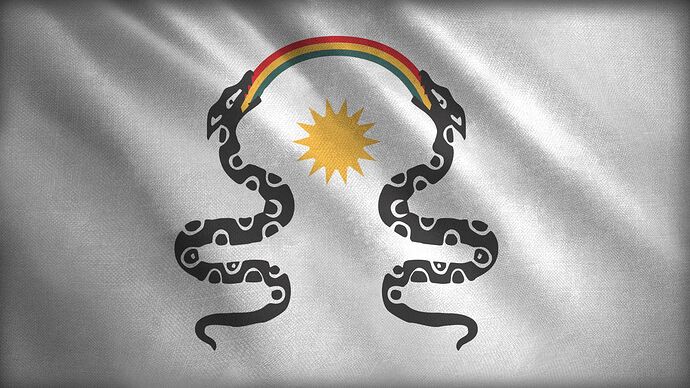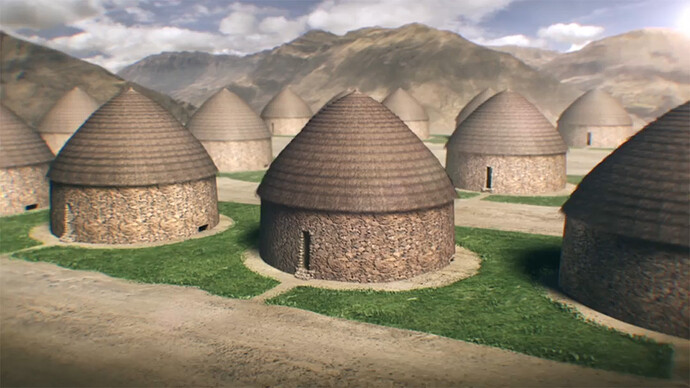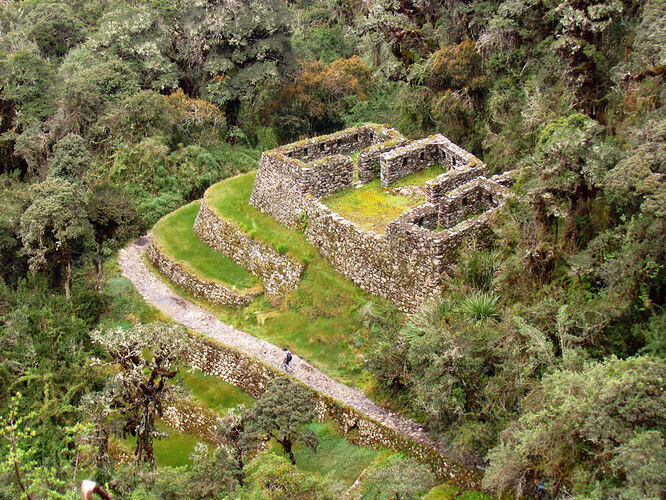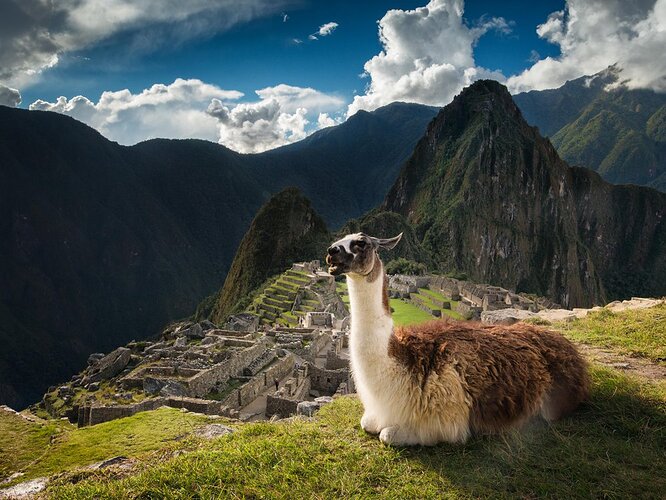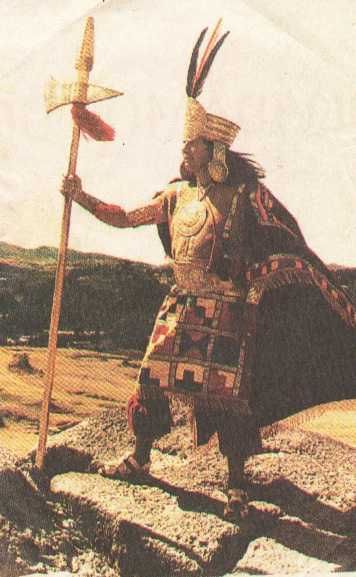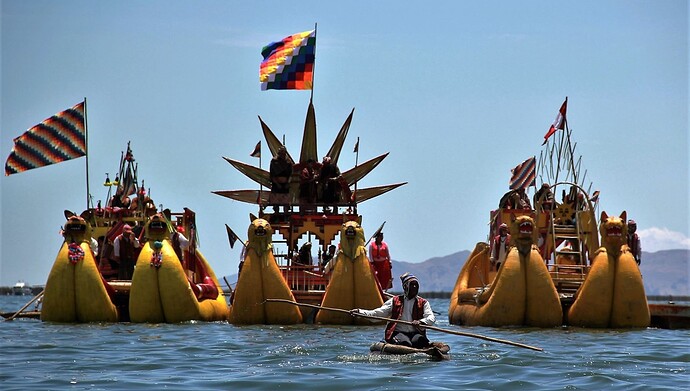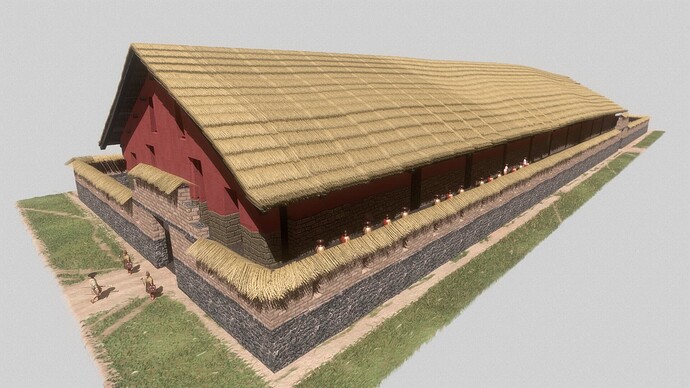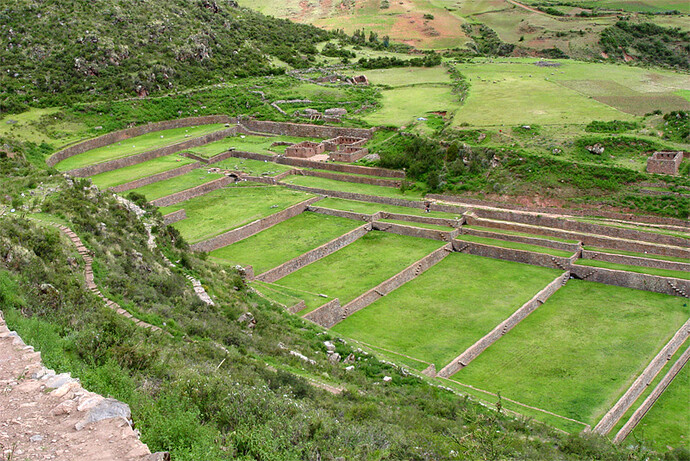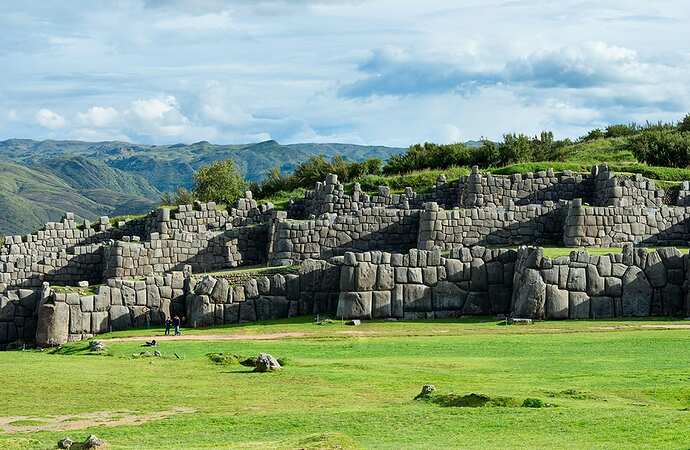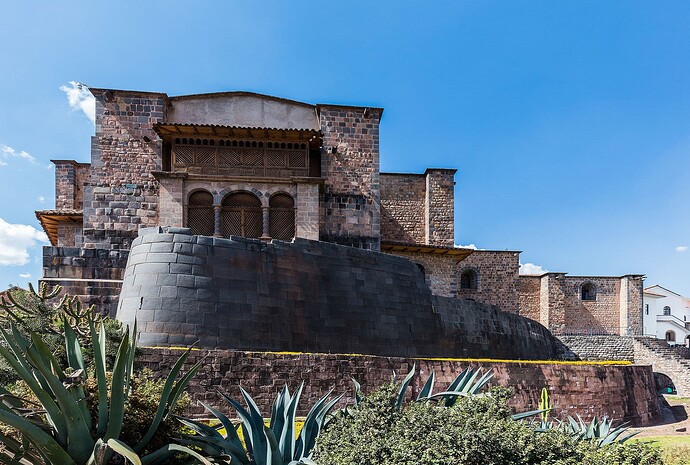Inca
The Inca empire
Roadnetwork, Flexibility, Llama
Difficulty: 2/3
Bonuses
- Houses support 15 Population
- Inca units do not cost gold.
- Starts with 2 Llamas
- Traders generate food instead of gold.
- Markets are only able to trade between food/wood/stone.
- Landmarks only cost Gold x 3.
- Unique Building: Inca Roads
- Unique Building: Qullqas
- Unique Building: Tambo (Replaces Towers)
- Unique Building: Terrace Farms
- Unique Unit: Chasqui
- Unique Unit: Kamayuk (Replaces Spearman)
- Unique Unit: Warak’a (Replaces Slingers)
- Unique Unit: Laborer. (Replaces villagers)
- Unique Unit: Acclas (replaces Monks)
- Unique Unit: Chincha Rafts
Central Planning**:** Units Garrisoned within a Colcan, Tambo or Keep can be changed into any other unit type.
Capac Ñan: Roads provide significant boost to movement speed boost when connected to a Tambo. Colcacan and Terrace farms also require to be built next to roads.
Royal Treasury: Gold stored up provides different tier of buffs that applies for the entire civilization, for every 1000 gold in storage, Gathering rate of villagers and laborers is increased and Production and Research speed is reduced by 10% to a maximum of 100%.
Unit Rooster:
- Age I: Villager
- Age I: Pathfinder
- Age I: Kamayuk (Unique)
- Age I: Laborer (Unique)
- Age II: Archer
- Age II: Warak’a (Unique)
- Age II: Atlatl
- Age III: Man at Arms
- Age III: Acllas (Unique)
- Age IV: Handcannoneer (Landmark Unique)
- Age IV: Horseman (Landmark Unique)
- Age IV: Lancers (Landmark Unique)
- Age II: Siege Platform
- Age III: Siege Pyre (Platform Variant)
- Age II: Siege Tunneler (Platform Variant)
- Age II: Siege Tower (Platform Variant)
- Age III: Siege Mantlet (Platform Variant)
- Age IV: Bombards (Landmark Unique)
- Age IV: Culverins (Landmark Unique)
- Age I: Chincha Raft
- Age II: Chincha Trade Raft
- Age II: Chincha Attack Ship (Attack Ship)
- Age III: Chincha Fireship (Demoship)
Building Rooster:
- Age I: House
- Age I: Inca Roads (Unique)
- Age I: Qullqa (Unique)
- Age I: Tambo (Unique)
- Age I: Terrace Farms (Unique)
- Age I: Outpost
- Age I: Palisade Gate
- Age I: Palisade Walls
- Age I: Siege Ladders
- Age II: Docks
- Age II: Market
- Age II: Town Center
- Age II: Craftsman Hut
- Age II: Stone Wall Tower
- Age II: Stone Wall Gate
- Age II: Stone Wall
- Age III: Keep
Technology Rooster:
Qullqa
- Age I: Llama Domestication (Unique)
- Age I: Survival Techniques
- Age I: Wheelbarrow
- Age II: Horticulture
- Age III: Fertilization
- Age IV: Precision Cross-Breeding
- Age I: Forestry
- Age II: Double Broadaxe
- Age III: Lumber Preservation
- Age IV: Crosscut Saw
- Age II: Specialized Pick
- Age III: Acid Destilization
- Age IV: Cupellation
Town Center
- Age II: Textiles
- Age II: Khipu accounting (Unique)
- Age II: Endurance Running (Unique)
Barracks
- Age II: Blowgun
- Age III: Porra Clubs (Unique)
Tambo
- Age II: Arrow Slits
- Age II: Fortify Outpost
- Age III: Atlatl emplacement
- Age III: Tower Altar
- Age IV: Slinger Platforms
Blacksmith
- Age II: Siege Engineering
- Age II: Fitted Leatherwork
- Age II: Thick Woven Capes
- Age II: Bronze Arrows
- Age II: Bronze Blades
- Age III: Insulated Helm
- Age III: Quilted Cotton
- Age III: Balanced Projectiles
- Age III: Bronze Reinforcement
- Age III: Wallqanqa (Unique)
- Age III: Military Academy
- Age IV: Salt Brine Coating
- Age IV: Master Smiths
Market
- Age III: Treasure trade (Unique)
- Age IV: Llama curiers (Unique)
Archery Range
- Age III: eBolas(Unique)
Docks
- Age II: Extended Lines
- Age II: Additional Sails
- Age III: Drift Nets
- Age III: Central Castle (Unique)
- Age III: Armored Hulls
- Age III: Navigator Lookout
- Age IV: Balsa Planking (Unique)
Temple
- Age I: Piety
- Age III: Herbal Medecine
- Age IV: Tithe Barns
Keep
- Age III: Boiling Oil
- Age III: Javelin emplacements
- Age IV: Slinger Platforms
University:
- Age IV: Guirilla Traps
- Age IV: Road Traps(Unique)
- AgeIV: Elite Army Tactics
- AgeIV: Incendiary Arrows
- AgeIV: Court Architects
- AgeIV: Siege Works
- AgeIV: Geometry
- Age IV: Fine Masonry (Unique)
*Common
*Native American
*Civilization Unique
Unique Landmarks
Feudal Age:
- Kallankas: Provides 50 population, is able to produce any infantry units.**
- Tipon Waterworks: Reduces cost of farms by 50%, farms built within its influence provides 10% more food.
Castle Age:
-
Usnu: Functions as a market and reduces cost of Colcas by 33%. All roads linked to the Usnu does not cost any stone.
-
Sacsayhuamán: Functions as a fully upgraded keep, reduces cost of all non-siege units by 30%. Infantry is now able to rearm instantly at any Keeps, Tambo and Culcas.**
Imperial Age:
-
Intikancha: Produces 3 Acclas every 90 seconds. Acclases now has a an Brain Surgeon aura that effects all friendly non-siege units, giving them a 10% chanse of being revived at the temple (Under their controll). Relics stored in this building increases the chanse by additional 10% per relic.**
-
Palace of Túpac: Is able to produce Bombards, Culverins, and Lancers, Infantry can be turned into Horsemen or Handcannoneers near the Palace. (These units keep their original cost)
Wonder: Temple of the Sun (Machu Picchu)
Unique Buildings:
- Inca Roads (Age I, 5S): Creates Roads that boost the movement speed of units moving on top of it. Constructed same way as stone walls, Can also be built over Mountain terrain, allowing passage through mountains. Roads can not be Deleted or Destroyed and has to be Deconstructed by a Laborer. Other buildings can overlap with roads, removing the road underneath. Some Inca unique buildings requires connection to inca roads.
-
Qullqa (Age I, 150W):
A supply depo that allows Garrisoned Inca infantry unit to change armaments within its radius. Able to garrison 20 units. Infantry units takes 15 seconds to re-arm. Requires connection to Inca Road. Functions as a universal drop-off point. -
Tambo (Age I, 100S):
A tower that increases movement speed on Roads connected to it by 25%. Is able to Garrison up to 8 units, and provide extra vision and 5 population. Also functions as a Colcas.** - Terrace Farms (Age I, 50W 50S): Needs to be connected to a road, but can be constructed on Mountains. Terrace Farms provides +3 extra food.
Unique Units:
- Chasqui:
When enemie units are spotted by a Chasqui, their movement can still be seen even through fog of war for 5 seconds.
- Laborer (Age I, 100F): Functions as a Villager but counts as Infantry, can be turned into any Infantry unit by a Colcas, Tambo or Keeps. Has a high movement speed
-
Llama(Age I, 200G):
Provides 350 Food. Can also be herded by Porters(Traders), boosting the Porters movement speed by 25%.
-
Kamayuk (Age II, 60F 40W ):
A more durable spearman with extra long reach. -
Warak’a (Age II, 80F 20W):
Specialized slinger that does higher damage and able to immobilize units with Bola Ability. -
Acclas (Age III, 200F):

Functions as a Monk, but upon death, it grants all nearby units healing over time effect that lingers for 5 seconds.
Unique: Technologies
- Llama Domestication (Age I, 75F 50G): Able to purchase Llama for Gold from mills. Upgraded at Mills.
- Endurance Running(Age II, 300G): Laborers movement speed increased by 5%. Upgraded at Town Center.
- Khipu Accounting (Age II, 250G): Trading between resources are more favorable Upgraded in Market.
- Treasure Trade (Age III, 425G): Traders generate additional 20% Gold/Wood/Food/Stone. Upgraded at Market.
- Bolas (Age III, 100S 350G): Warak’a gains Bolas ability, when activated, their first attack immobelizes the target for 3 seconds. Upgraded at Archery Range
- Wallanqa (Age III, 250W 300G): Increases range armor by +1 (Upgraded at Blacksmith)
- Porra Clubs (Age III, 350G): Man at arms deal +3 damage against heavy.
- Central Castle (Age III, 600G): Increases health of Chincha Attack ships by +200 and their ranged armor by +1. Upgraded at Docks
- Llama Curier (Age IV, 300F 700G): Traders movement speed increased by 15%
- Balsa Planking (Age IV, 300F 700G): Increases the health of Chincha Attack ships by +200. Upgraded at Docks.
- Road Traps (Age IV, 500S): Only placable on Roads going through Mountain mountains. Deadly boulder traps that does significant aoe damage to enemie units using the Inca Roads. Upgraded at University
- Fine Masonry (Age IV, 300F 700G): Buildings takes 33% reduced damage. Upgraded at University.
Additional Notes:
Architecture:
Much of what the early Inca knew about architecture they acquired from the Tiahuanaco culture. These people thrived on the southern shores of Lake Titicaca in what is today known as the country of Bolivia. The Tiahuanaco were master architects, masons, and stone cutters. They were known to fit carved stones so close together that the mortar was almost invisible. The use of rectangular plans for their streets, buildings, and courtyards, as well as the idea of tight polygonal joints came from Tiahuanaco people. Master masons from this area were imported by the IncaBlocks of stone had to be cut, ground, and polished until the outer surfaces locked perfectly. Today, we are still not certain how the Incas cut stone. The Inca had no wheels, cranes, or lifting devices. Their architects used geometric shapes when building, and trapezoids were used extensively for doorways, windows, and alcoves. Inca architects incorporated springs and steams into their work whenever they could. The Inca used thatched roofs, and sometimes they were very elaborate. In some cases they were so densely woven that they would last for years. All of the temples used thatched roofs, even the Coricancha. The Inca were conservative architects. They relied on proven methods. They never did excel in woodworking.
Naval units:
While not much is known about Inca Maritime power, we do know that the inca state of Chincha was a powerful and far-reaching maritime power that had an extensive maritime trade network. Their ships were solidly built, not with just wood, but with interwoven reeds.
There have been many theories about the Incas having contact with the Polynesians and traded with them. The famous explorer Thor Heyerdahl and his Kon-Tiki expedition were to prove the Inca could be capable of sailing across the pacific.
Language progression:
Classical Quechua is either of two historical forms of Quechua, the exact relationship and degree of closeness between which is controversial, and which have sometimes been identified with each other.
- the variety of Quechua that was used as a lingua franca and administrative language in the Inca Empire(1438–1533)
- the variety of Quechua that was used in writing for religious and administrative purposes in the Andean territories of the Spanish Empire, mostly in the late 16th century and the first half of the 17th century and has sometimes been referred to, both historically and in academia, as lengua general (‘common language’)
Landmark references:
-
Kallankas:
These were large rectangular enclosures, up to 70 meters long, associated with important state centers. The structures, mentioned as “barns” in the chronicles due to its size. The best example is the kallanka of Huchuy Qosqo. Due to its importance as political or military administrative center, several functions have been attributed to it such as: Headquarters or barracks for the soldiers of the empire, places of public meeting or assembly, palaces or lodgings for important individuals, or finally as a multi-role building (it had to be adapted to different purposes and situations).** -
Tipon Waterworks:
Tipon is a self-contained, walled settlement that served as an estate for the Inca nobility. Located 13 miles down the Huatanay River Valley by the Inca capital of Cusco, the 500-acre archeological site provides knowledge and better understanding of the pre-historic Inca and their irrigation and building skills. The site represents great mastery of irrigation and hydraulic technology. The civil engineers of Tipon designed buildings, 13 integrated central terraces, waterworks, hundreds of other terraces, and massive structures to be visually and functionally harmonious with their surrounding** -
Usnu:
A special platform for important celebrations,in the town Vilcashuamán. Vilcas was a principal and very important place in the Incan kingdom. “There were beautiful buildings and a temple with great wealth.” The natives, “burned the most important of them and removed the sacred women and treasures so that the Spaniards could not take advantage of them. Two royal highways, if not three, lead from this place that they call Vilcas.” -
Sacsayhuamán:
is a citadel on the northern outskirts of the city of Cusco, Peru, the historic capital of the Inca Empire. The complex was built by the Inca in the 15th century, particularly under Pachacuti and successors. They built dry stone walls constructed of huge stones. The workers carefully cut the boulders to fit them together tightly without mortar. The site is at an altitude of 3,701m -
Intikancha:
Also known as Coricancha,(“The Golden Temple,”) was the most important temple in the Inca Empire. It was dedicated to Inti, and is located at the former Inca capital of Cusco. Most of the temple was destroyed after the 16th-century war with the Spanish conquistadors, as settlers also took it apart to build their own churches and residences. Much of its stonework was used as the foundation for the seventeenth-century Santo Domingo Convent. It was built after the 1650 earthquake destroyed the first Dominican convent.To construct Coricancha, the Inca used ashlar masonry, building from the placement of similarly sized cuboid stones that they had cut and shaped for this purpose. The use of ashlar masonry made the temple much more difficult to construct, as the Inca did not use any stone with a slight imperfection or break. By choosing this masonry type, the Inca intentionally demonstrated the importance of the building through the extent of the labor necessary to build the structure. Through the arduous labor needed to construct buildings with ashlar masonry, this form of construction came to signify the Inca’s imperial power to mobilize and direct local labor forces.[14] The replication throughout Andean South America of Inca architectural techniques, such as those employed at Coricancha, expressed the extent of Inca control over a vast geographic region. -
Palace of Túpac:**
Sayri Tupac’s father Manco, the last ruling Inca emperor, had attempted to reach an accommodation with the Spanish conquistadors. He was crowned emperor in 1534 by Francisco Pizarro. However, his cooperation was severely tested by mistreatment at the hands of Francisco’s brothers Gonzalo, Juan and Hernando, whom Francisco had temporarily left in charge in Cuzco. Manco escaped from the city in April 1536 and raised a large army of Inca warriors. For ten months he besieged Cuzco but failed to take the city. Two years later Manco got killed by Spaniards who took refuge in Manco’s residence. Sayri Túpac was nine years old at the time. He became Inca in Vilcabamba, reigning for ten years with the aid of regents. This was a time of peace with the Spanish. Viceroy Pedro de la Gasca offered to provide Sayri Túpac with lands and houses in Cuzco if he would emerge from the isolated Vilcabamba. Sayri Túpac accepted, but during the preparations his relative Paullu Inca suddenly died. This was taken as a bad omen (or a sign of Spanish treachery), and Sayri Tupac remained in Vilcabamba.
Wonder:
- Temple of the Sun (Machu Picchu): Only priests and other high ranking Incas were likely only permitted access into the Temple of the Sun, one of the most sacred temples in all of Machu Picchu.Adapted to the natural environment, the unique semi-circular construction of the temple is built over an enormous granite rock and there’s a tower with a trapezoidal window. In this sacred temple, it’s believed that Incas worshipped their Sun God, Inti and may have served as a royal tomb.
Unique Unit:
Chasqui:
- Health: 95
- Attack: 4 Melee (Spear); 4 (Blowgun); +10 vs scout, + 12 vs wildlife.
- Rate of Fire: 2s (Spear); 1s (Blowgun);
- Range: 5
- Armor: 0
- Pierce Armor: 0
- Speed: 1.38
Note: Benefits from villager upgrades as well as blacksmith upgrades.
Laborer:
- Health: 75
- Attack: 6 Melee (knife); 12 melee (Spear); 3 bow (range); 10 Torch; +2 vs siege (torch)
- Rate of Fire: 3.75s
- Range: 5
- Armor: 0
- Pierce Armor: 0
- Speed: 1.25
Note: Benefits from villager upgrades as well as blacksmith upgrades.
Kamayuk:
- Health: 85/105/130/155
- Attack: 6/8/9/11 Melee (Kunka Kuchuna); +15/20/23/28 vs Cavalry
- Rate of Fire: 1.75s (Kunka Kuchuna);
- Range: 2.5 tiles (Kunka Kuchuna)
- Armor: 0
- Pierce Armor: 0
- Speed: 1.25 tiles/s
Note :
Warak’a
- Health: 70/80/95
- Attack: 8/10/12 (Slingshot); +3/4/4 vs Cavalry
- Rate of Fire: 1.3 (Slingshot)
- Range: 6 tiles
- Armor: 0
- Pierce Armor: 0
- Speed: 1.38 tiles/s
Note: Warak’a are mobile ranged units with bonus attack vs cavalry, they also have unique Bola ability that immobilizes units on their first attack.
Acclas:
- Health: 90
- Attack:0
- Rate of Fire: 0
- Range: 0
- Armor: 0
- Pierce Armor: 0
- Speed: 1.12 tiles/s
Note: Upon death, it grants healing over time to all nearby units for 5 seconds. Intikancha landmark grants them the effect that any friendly units who die nearby has a 10% of being revived near the Landmark under the players controll. The effect does not stack.
Write-up: The Inca empire, a once mighty empire that ruled and expanded over an otherwise impossible empire.
I don’t know what’s the deal with Native Americans, but they certainly love putting their Civilization in HARD MODE starting positions.
The Inca empire was impressive, not only because of its immense wealth and being able to make an empire.
Not, these boys actually manage to make a functional socialist empire. If the US had existed the way it was during the 50’s, they would have deemed the Incas as hardcore commies.
Why? Because Incas didn’t use Money! Their entire government had a centralized system, and currency was in form of… LABOUR. Yes, the empire provided its people with all the necessities, but in return, the people had offer their labour.
Do you need clothes and food for the upcoming winter? Here! But in return, you gotta work on this massive structure we are building for the GOD EMPEROR for 2 years.
Hence, why they were able to build otherwise impossible mega projects, such as their extensive mountain road networks and semi-suicidal rope bridges (safe to use once finished, but falling to your death under construction was more than common, but dying building these bridges would give you martyrdom and your family special privileges).
Also another thing, every single Inca had to work from the ground up in terms of their riches.
While there were nobles and people of higher standing.
No one would be able to leech off heritage wealth. Why? Because people were literally immortal in Inca culture. If you died. You weren’t really dead. The Dead played an important role in the Inca lifestyle. They would be mummified, adorned, and preserved. They would participate in family dinners just as much as family discussions, as well as governmental affairs. How they did it? I dunno, probably Trippin on local herbs. But regardless. This meant that their possessions, such as land ownership, standing, and wealth were kept even postpartum. Meaning every new generation had to earn their own wealth. While nobility definitely started with an advantage and usually kept their standing well due to their heritage (remember, even if your parents who were nobles were dead, the family would still be considered as nobles). This would quite often lead to… Interesting conflicts. Such as stealing or kidnapping mummies and henceforth.
But back to the Inca empire, their road network, just like the Roman empire, played an incredibly important role in their expansion. While they didn’t have draft animals, the way they manage to quickly move huge troops across the empire, was the use of Qullqas, Storage houses filled with Arms, and armament. The troops would travel with provisions only, stationed at the nearest Qullqas, and rearm themselves near the frontline. Along the road were also Tambos, that function as outposts along the road, but quite often they would also be housing for noble families and serve the same role as Yam Network did for the Mongols. Their communication was extremely efficient, without the use of horses and only the use of a half-naked running man, a message could be relayed from the outer edges of the empire to the capital, in a matter of 2 days.
Who were the Messengers? Well, they could be anyone! This is also why Tambos quite often served as Noble houses, as this nobility were in charge of managing the Currency, the currency of Labour.
They were usually in charge of a regional area, where they would keep track of people and what they owed in labor, They would find the one most fit and known for being a good runner, and have them do the running to the next Tambo.
Remember, in Soviet Inca, You do not send the message. The Message sends YOU!
Quite literally.
But in regards to the gameplay. This makes them very intersting. The Inca didn’t use gold for money, while they certainly mined gold and used it extensively, it wasn’t used as currency and was mostly something to be used to adorn their dead and the living, as well as religious temples and royal palaces.
The Inca are also unique in the fact they have labourers instead of villagers.
They are more expensive than a villager, but they are far more effective, they also are able to use Colcas to rearm themselves to be any infantry type needed. This gives them unparalleled flexibility where they can focus on going full out econ or military expansion and collecting gold becomes their age-up mechanic.
So it will always be a balance between growing your econ or your military, or aging up or upgrading techs. And Banking up on gold also grants the Inca special boons, a literal version of Abbasid golden age in a sence.
Next up: Mayans or Aztecs. IDK. You choose.
AoE4 Civ Concept: Maya
AoE4 Civ Concept: Aztecs
For more information regarding generic native american units:
AoE4 Civ Concept: Native American BASIS.
